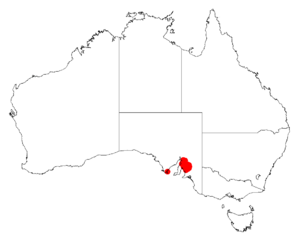Spiller's wattle facts for kids
Quick facts for kids Spiller's wattle |
|
|---|---|
| Conservation status | |
| Scientific classification | |
| Genus: |
Acacia
|
| Species: |
spilleriana
|
 |
|
| Occurrence data from AVH | |
Spiller's wattle (Acacia spilleriana) is a special type of shrub. It is also known as a wattle. This plant belongs to the Acacia family. You can find it growing naturally in southern Australia.
Contents
What Spiller's Wattle Looks Like
This shrub usually grows to be about 1 to 2 metres (3.3 to 6.6 ft) tall. It has a nice rounded, bushy shape and spreads out. Its small branches are covered with soft hairs. Older parts have yellowish hairs, while new shoots have silvery-white ones.
Leaves and Flowers
Spiller's wattle has small, greyish, rounded "leaves" called phyllodes. These are actually flattened leaf stalks that act like leaves. They are grey-green to silvery and can be oval or egg-shaped. Each one is about 2 to 3 cm (0.79 to 1.18 in) long and 1 to 2 cm (0.39 to 0.79 in) wide.
The plant produces bright golden flowers. These flowers grow in round clusters, like little balls. Each cluster has 30 to 40 tiny yellow flowers. They grow on long stalks from the leaf axils (where the leaf meets the stem).
Seed Pods
After the flowers bloom, seed pods start to form. These pods turn dark grey or black when they are ready. They are about 5.5 cm (2.2 in) long. Inside each pod, you will usually find one or two seeds.
Where Spiller's Wattle Grows
Spiller's wattle is found only in a small part of South Australia. This means it is endemic to that area. It grows in patches, so you might not see it everywhere.
Natural Habitat
You can find it in the northern parts of the Mount Lofty Ranges near Burra and Auburn. It also grows in the southern parts of the Tothill Ranges. This plant likes to live in open Eucalyptus woodlands and mallee areas.
There is also a group of these plants at the southern tip of the Eyre Peninsula. Scientists think this group might have spread there naturally. The total area where Spiller's wattle grows is about 1,800 km2 (690 sq mi).
Growing Conditions
This wattle prefers rocky hills, areas along creeks, and roadsides. It grows best in soils that have a loamy top layer over red clay. These soils are usually alkaline (not acidic) and drain water well.


